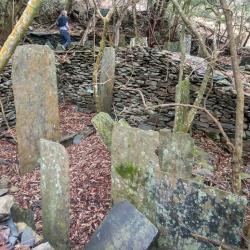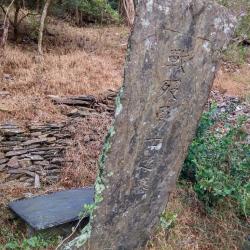The ancestral spirit house is the most sacred place for the Paiwan people. Each clan has its own ancestral spirit house. During the millet harvest festival and the five-year festival, people from the same clan will return to the ancestral spirit house to reunite. In addition, each tribe has its own ancestral house. During the festival, priests, shamans, and leaders perform various ceremonies there, and outsiders are not allowed to participate. The ancestral spirit house is built with stone slabs. Except for the most important ancestor statues, there is almost no other furniture inside the house. Only wooden frames are nailed to the surrounding walls, on which are placed precious earthen pots, copper pots and other collectibles. In addition, vine balls and sharpened poles from the five-tear festival, tusks of wild boars, skulls, eagle feathers, claws, and teeth of the bears are also collected in the ancestral spirit house to pass on to future generations. There are two ancestral houses in Kulou Village. The earliest cinekecekan is located at the turning point of Zhongshan Road. Later, due to the increasing population in the village, the hunting ancestral spirit house (rusivawan) was added on the side of Zhongzheng Road.
Kunlun'ao

The Old Gulou Hamlet is located on a steep slope, on the south-eastern side of Mount Wuwei in Laiyi Township, Pingtung County. It is at an altitude of about 1,150 meters. The traditional Paiwan name for the place is Kuljaljau, though it is also known as Kulun’ao and Jalongya.
During the Japanese occupation, the hamlet was the largest indigenous settlement. There were five close-knit tribes, among which Umaq was the first to be developed, and the others were derived from this. At the end of the Japanese occupation, as Old Gulou Hamlet centered on the Kunanau Police Post at that time, the Government-General in Taiwan encouraged the tribes to move to Taimali Township and Daren Township in Taitung County in order to divide the tribe.
In the early post-war period, the National Government also arranged a collective relocation of the hamlet to the current Gulou Hamlet.

Located in Laiyi Township, Pingtung County, there is a tombstone at the entrance of the old Gulou Hamlet, which is engraved with the words “Tomb of warriors who died in the battle”. It was the tragic death of those indigenous peoples who joined the Takasago Volunteer Team and fought in the Pacific War that occurred at the end of the Japanese Occupation period. The rectangular tomb covered with stone slabs is a joint burial site for these men.
During the Second World War, Taiwan’s Government-General organized a group of young indigenous peoples to assist in the war in Nanyang. This organization, commonly known as the Takasago Volunteer Team, was dispatched several times. In 1942, the first batch of 500 Takasago volunteers came forward to serve the country. They went to the Philippines to fight, and later were even reorganized into the special task force.
Kashan is located in Laiyi Township, Pingtung County, on the north side of the mountain, at about 1,250 meters above sea level. Kashan has a section of the Kunlun’ao Trail, which was the first road excavated to manage indigene in the Qing period. During the Japanese occupation, the Government-General in Taiwan used part of the Kunlun’ao Trail as a Lifan road (indigene management route), starting from Chaozhou in the west, passing through Laiyshe, and arriving at the Guloushe. From the east, the trail goes from Jinlunshe, passing by the Huangshe and reaching the Zhuyegeshe. The middle section that crosses the central mountain range is left unused.
The old Laiyi Hamlet, in Laiyi Township, Pingtung County, is located on the mountainside on the left bank of the upper reaches of Neishe River. It is about 360 to 600 meters above sea level. There are two hamlets. The larger one on the southeastern side is called Chajiakavus. The smaller one on the northwestern side is called Chingasan, which stemmed out from the larger hamlet. In fact, during the Japanese occupation, the Government-General in Taiwan set up a police post in Laiyishe. In the early post-war period, the tribes were forced to collectively relocate their villages to the present Laiyi Hamlet.
To get to Old Laiyi Hamlet, enter from the fork road on the 6.5 km point of Yilin Road, and you will see the stone stele of the old Jala’afus tribe at the entrance. There are still large-scale slate houses in the hamlet ruins.